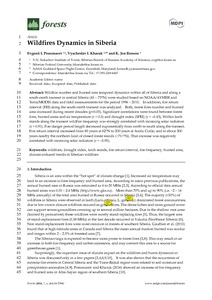Wildfires Dynamics in Siberian Larch Forests
Скачать файл:
DOI:
10.3390/f7060125URI (для ссылок/цитирований):
http://www.mdpi.com/1999-4907/7/6/125https://elib.sfu-kras.ru/handle/2311/69899
Автор:
Харук, Вячеслав Иванович
Пономарев, Евгений Иванович
Ranson, Kenneth J.
Коллективный автор:
Институт экологии и географии
Кафедра экологии и природопользования
Дата:
2016-06Журнал:
ForestsКвартиль журнала в Scopus:
Q1Квартиль журнала в Web of Science:
Q2Библиографическое описание:
Харук, Вячеслав Иванович. Wildfires Dynamics in Siberian Larch Forests [Текст] / Вячеслав Иванович Харук, Евгений Иванович Пономарев, Kenneth J. Ranson // Forests. — 2016. — Т. 7 (№ 6). — С. 1-9Аннотация:
Wildfire number and burned area temporal dynamics within all of Siberia and along
a south-north transect in central Siberia (45–73 N) were studied based on NOAA/AVHRR (National
Oceanic and Atmospheric Administration/ Advanced Very High Resolution Radiometer) and
Terra/MODIS (Moderate Resolution Imaging Spectroradiometer) data and field measurements
for the period 1996–2015. In addition, fire return interval (FRI) along the south-north transect was
analyzed. Both the number of forest fires and the size of the burned area increased during recent
decades (p < 0.05). Significant correlations were found between forest fires, burned areas and air
temperature (r = 0.5) and drought index (The Standardized Precipitation Evapotranspiration Index,
SPEI) (r = -0.43). Within larch stands along the transect, wildfire frequency was strongly correlated
with incoming solar radiation (r = 0.91). Fire danger period length decreased linearly from south
to north along the transect. Fire return interval increased from 80 years at 62 N to 200 years at the
Arctic Circle (66,33’ N), and to about 300 years near the northern limit of closed forest stands (about
71+ N). That increase was negatively correlated with incoming solar radiation (r = -0.95).
Коллекции:
Метаданные:
Показать полную информациюСвязанные материалы
Показаны похожие ресурсы по названию, автору или тематике.
-
Large Wildfires in Taiga Subzones of Central Siberia
Valendik, Erik N.; Verkhovets, Sergey V.; Ponomarev, Eugene I.; Ryzhkova, Vera A.; Kisilyakhov, Yegor K.; Валендик, Э.Н.; Верховец, С.В.; Пономарев, Е.И.; Рыжкова, В.А.; Кисиляхов, Е.К. (Сибирский федеральный университет. Siberian Federal University., 2014-03)The work deals with the nature of large wildfires, conditions of their occurrence and distribution in the taiga of Central Siberia. The large fires in this region occur during periods of prolonged and intense drought, ... -
Labile pyrogenic dissolved organic carbon in major Siberian Arctic rivers: Implications for wildfire-stream metabolic linkages
Myers-Pigg, Allison N.; Louchouarn, Patrick; Amon Rainer, M. W.; Prokushkin, Anatoly; Pierce, Kayce; Rubtsov, Alexey (2015-03)Biomass burning produces a spectrum of thermally altered materials that releases pyrogenic carbon (PyC) to terrestrial, atmospheric, and aquatic systems. Most studies focus on the refractory end of the PyC spectrum, derived ... -
Wildfire Occurrence in Forests of the Altai–Sayan Region under Current Climate Changes
Пономарев, Евгений Иванович; Харук, Вячеслав Иванович (2016-01)Проанализирована динамика метеорологических показателей для Сибири и Алтае-Саянского региона в XX – XXI вв. Выявлены значимые тренды температуры, осадков и индекса сухости SPEI. Установлен тренд роста горимости территории ... -
Impact of silkmoth outbreak on taiga wildfires
Харук, Вячеслав Иванович; Антамошкина, Ольга Александровна (2017-10)We provide a quantitative analysis of postoutbreak wildfire frequency within the confluence of the Yenisei and Angara rivers affected by the Siberian Silkmoth (Dendrolimus sibiricus Tschetv.). A catastrophic outbreak was ... -
The Intensity of Wildfires in Fire Emissions Estimates
Ponomarev, E. I.; Shvetsov, E. G.; Kharuk, V. I. (2018-11)A method for estimating direct wildfire emissions that considers fire intensity based on infrared radiation data from the Terra/MODIS satellite is proposed. In Siberia, we experimentally established that low intensity fires ...

